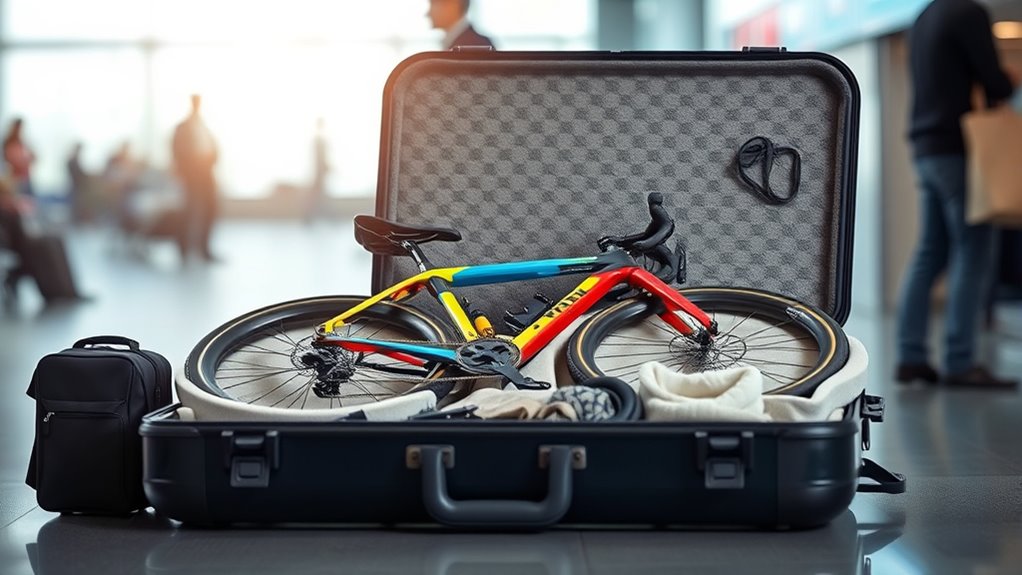To pack your bike for an international flight fast, start by allocating about an hour for the task. Shift your bike to the hardest gear for easier wheel removal. Use a sturdy bike bag or box and gather essential supplies like bubble wrap and multi-tools. Disassemble key components like handlebars and pedals, and cushion the frame. Don’t forget to check airline regulations for weight limits. Discover more about efficient packing techniques to keep your bike safe during transit.
Key Takeaways
- Allocate about an hour for packing to ensure you complete the process efficiently, especially if you’re a first-timer.
- Shift to the hardest gear on the rear cassette for easier wheel removal and to facilitate packing.
- Use a sturdy bike bag or cardboard box, and pack cushioning materials like bubble wrap to protect your bike’s frame and components.
- Securely detach and pack handlebars, using tape to mark their position for easy reassembly after travel.
- Ensure your packed bike meets airline weight limits to avoid oversize fees, typically around 50-70 lbs depending on the airline.
Quick Tips for Efficient Packing

When you’re packing your bike for an international flight, planning ahead can save you time and hassle. Allocate about an hour for this task, especially if it’s your first time.
Start by shifting your bike to the hardest gear on the rear cassette to make wheel removal easier. Then, remove the handlebars and securely place them in your bike bag. Use bubble wrap or foam noodles to protect your frame and components.
Don’t forget to pack your bike tools for reassembly. For the wheels, consider using wheel bags for added protection.
Remember to keep small parts like washers and screws organized in labeled bags to streamline your reassembly process and prevent loss during your travels.
Essential Packing Supplies
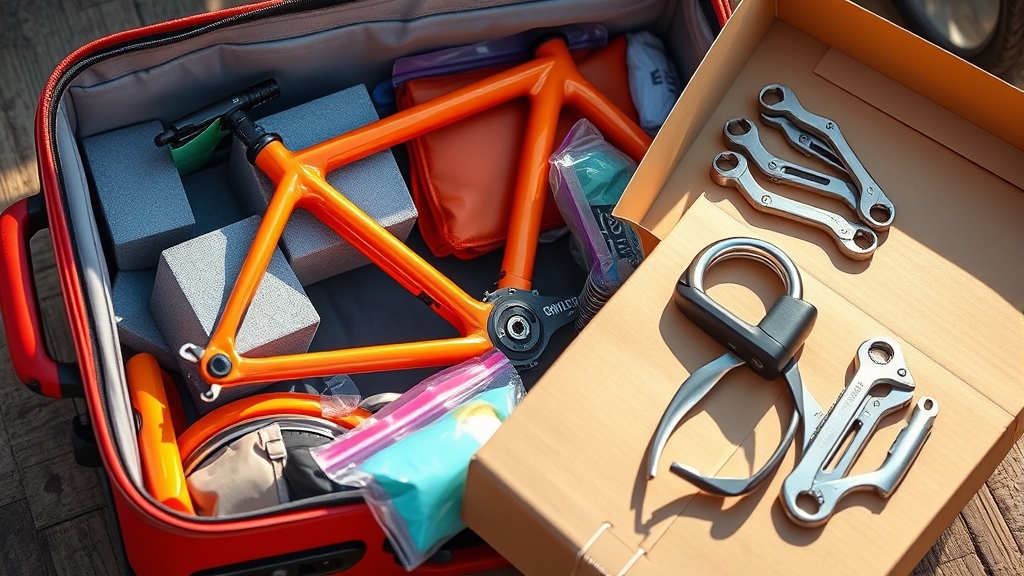
Packing your bike for an international flight requires the right supplies to guarantee it arrives safely at your destination.
You’ll need a sturdy bike bag or a cardboard bike box, depending on your budget and protection needs.
Don’t forget to gather these essential items:
- Multi-tools for disassembling components like pedals and handlebars
- Wheel bags to protect your wheels during transit
- Foam pipe lagging and bubble wrap for cushioning frame components
- Brake spacers or small cardboard squares to prevent brake pistons from advancing
As you prepare for packing your bike, make certain to carefully remove parts and pack them securely. The use of vetted gear recommendations can also help you choose the best protection for your bike.
With the right supplies, you can guarantee your bike arrives in perfect condition!
Step-by-Step Bike Disassembly

With the right supplies gathered, you’re ready to start disassembling your bike for transport.
Begin by shifting to the hardest gear on the rear cassette to make wheel removal easier. Lower the dropper post to its minimum height and detach the pedals, keeping the washers in a secure bag for reassembly.
Next, remove both the front and rear wheels, replacing the axles to protect the dropouts. Detach the handlebars and faceplate, marking their position with tape for easy reattachment. Secure small parts together to avoid losing them.
After that, use zip ties to secure the rear derailleur to the chainstay and insert brake spacers between the brake pads to prevent piston advancement during transit.
Your bike is now ready for the travel bag!
Packing Techniques for Protection
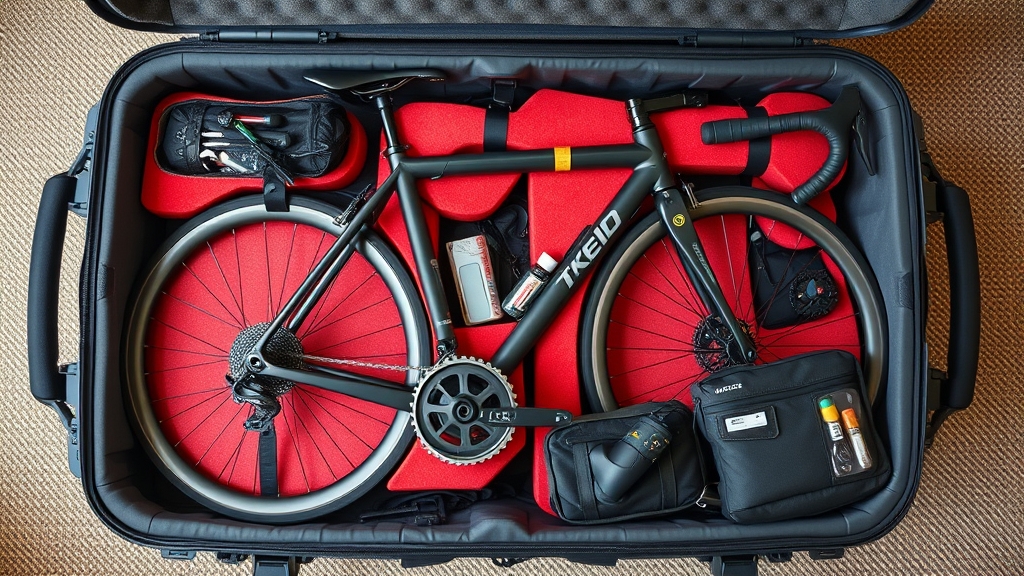
To guarantee your bike arrives at your destination unscathed, it’s crucial to use effective packing techniques that safeguard all its components. Start by ensuring you remove the stem and pack it separately. Use bike bags designed for travel, and add extra padding to vulnerable areas.
Here are some important packing techniques:
- Wrap the frame and components with foam pipe lagging or bubble wrap.
- Remove and securely pack disc rotors between cardboard to avoid bending.
- Insert brake spacers between brake pads to prevent piston advancement.
- Securely tie down handlebars and other protruding components with zip ties.
Filling empty spaces with cushioning materials like bubble wrap will prevent shifting and impact damage, ensuring your bike stays protected throughout its journey.
Airline Regulations and Weight Limits
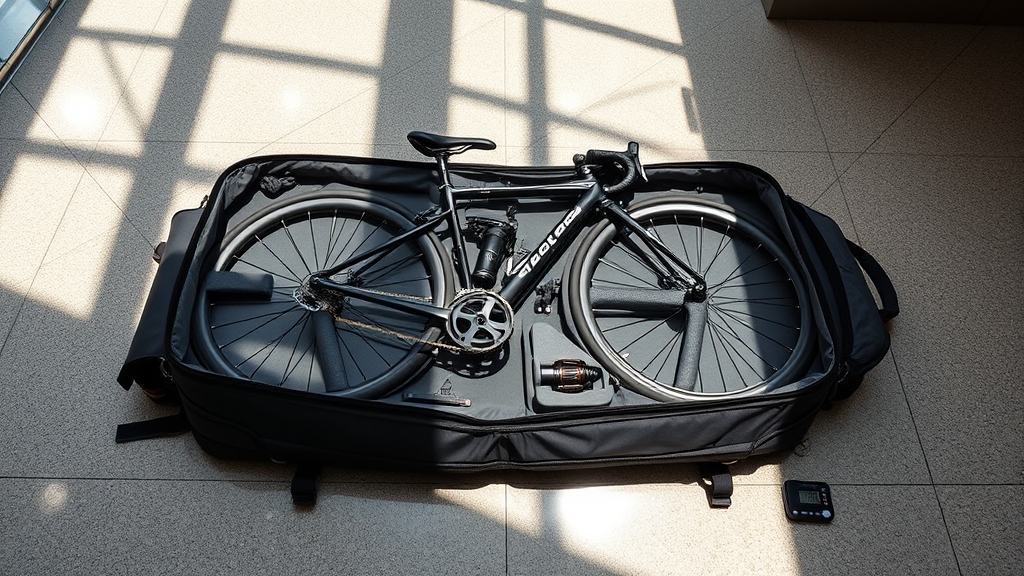
After ensuring your bike is well-protected, it’s important to familiarize yourself with airline regulations and weight limits. Most airlines impose a standard weight limit of around 50 lbs (23 kg) for checked baggage. If your bike bag exceeds this limit, expect oversize fees that can greatly impact your budget.
Here’s a quick reference table for you:
| Airline | Weight Limit | Oversize Fees |
|---|---|---|
| Airline A | 50 lbs | Starts at $100 |
| Airline B | 70 lbs | Starts at $75 |
| Airline C | 50 lbs | No fees for bikes |
| Airline D | 55 lbs | $150 for oversize |
| Airline E | 50 lbs | $50 for oversize |
Check your specific airline’s policies to avoid surprises.
Post-Travel Bike Maintenance
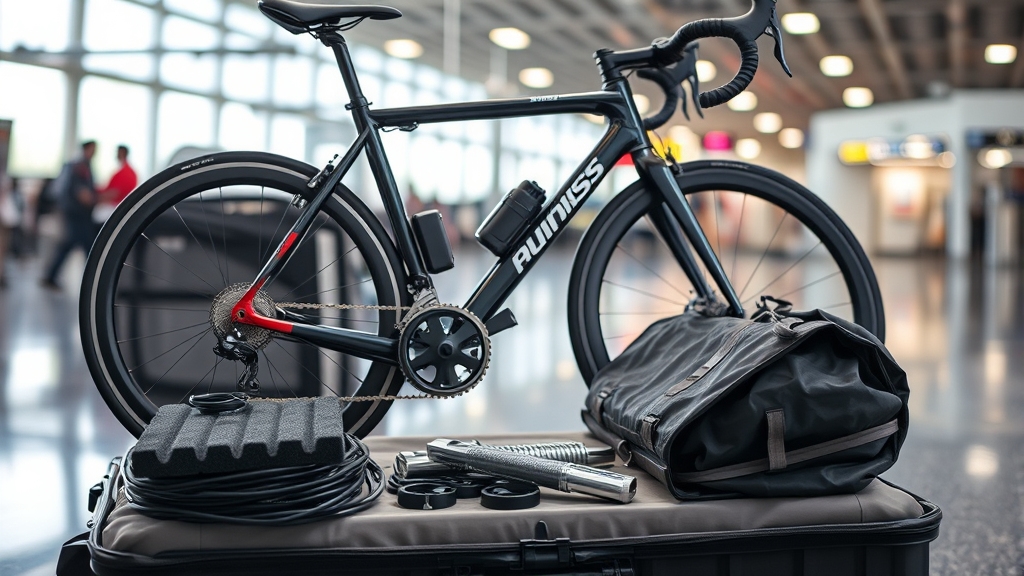
Once you’ve unpacked your bike, start by inspecting it for any damage that might’ve occurred during travel. Cleaning and lubricating the moving parts is essential to keep everything running smoothly. This initial maintenance sets the stage for a great riding experience ahead. Additionally, ensuring that your bike is well-maintained will enhance balance and coordination as you return to riding.
Inspect for Damage
As soon as you arrive at your destination, it’s crucial to inspect your bike for any damage that may have occurred during transit. A thorough visual inspection can save you from potential issues down the road.
Focus on these key areas:
- Bike frame: Look for dents, scratches, or misalignments.
- Components: Check the functionality of brakes, gears, and drivetrain.
- Tires: Inspect for proper inflation and any punctures or damage.
- Bolts: Verify all bolts are tight, especially on handlebars, seat post, and pedals.
Document any damage with photographs in case you need to file a claim with the airline.
Keeping records of repairs made post-travel will also help you stay organized for future rides.
Clean and Lubricate
Cleaning and lubricating your bike after travel is essential to confirm it performs at its best.
Start by giving your bike a thorough clean, removing dirt and grime from the frame, components, and drivetrain. This prevents corrosion and damage that could have occurred during transit.
Once it’s clean, lubricate the chain, derailleur, and all moving parts, including brake pivots, using a bike-specific lubricant to maintain functionality and prevent rust.
Don’t forget to check your wheels and tire pressure; inflate them to the recommended PSI to confirm they’re ready for the road.
After reassembly, a final inspection will help confirm your bike runs smoothly and efficiently, so you can enjoy your rides without worries.
Frequently Asked Questions
How to Carry a Cycle in an International Flight?
Carrying your cycle on an international flight requires careful preparation.
First, check your airline’s specific regulations regarding bike transport. You’ll need to disassemble your bike and pack it securely in a suitable bag or box.
Don’t forget to remove pedals and wheels, and use protective padding to prevent damage.
Once packed, weigh your bike and verify it meets size restrictions to avoid extra fees.
Finally, consider getting travel insurance for added peace of mind.
Will Fedex Pack a Bike?
You might think packing a bike is as easy as throwing it in a box, right?
Well, FedEx actually offers a packing service that takes the hassle out of it. They’ll disassemble your bike and wrap everything securely, ensuring it’s safe for shipment.
Just remember, prices vary based on size and destination, so it’s smart to get a quote first.
You can conveniently drop it off or schedule a pickup for international shipping.
How Do I Transport My Bike Overseas?
To transport your bike overseas, start by choosing a suitable bike bag or hard case that meets airline size and weight restrictions.
You’ll need to remove the pedals, wheels, and any protruding components. Protect sensitive parts with bubble wrap or foam padding.
Familiarize yourself with your airline’s bike transport policies and fees. Keep small parts organized in labeled bags, and consider using bike shipping services for added convenience and protection.
How to Pack a Bicycle for an Airplane?
Packing your bicycle for an airplane is like tucking a treasure into a protective cocoon.
First, you’ll remove the front and rear wheels, pedals, and any protruding parts. Secure them with zip ties and padding.
Use a sturdy bike bag or box, wrapping the frame in foam or bubble wrap. Deflate the tires, insert brake spacers, and keep small parts in labeled bags.
Don’t forget to check the weight—airlines can be strict!
Conclusion
With a little preparation, you can pack your bike for international travel in no time. Remember, it’s all about getting your ducks in a row before the trip. By following the tips and techniques outlined, you’ll guarantee your bike arrives safely and ready to ride. Don’t forget to check airline regulations and weight limits to avoid surprises at the airport. So gear up, pack smart, and hit the road with confidence on your next adventure!
